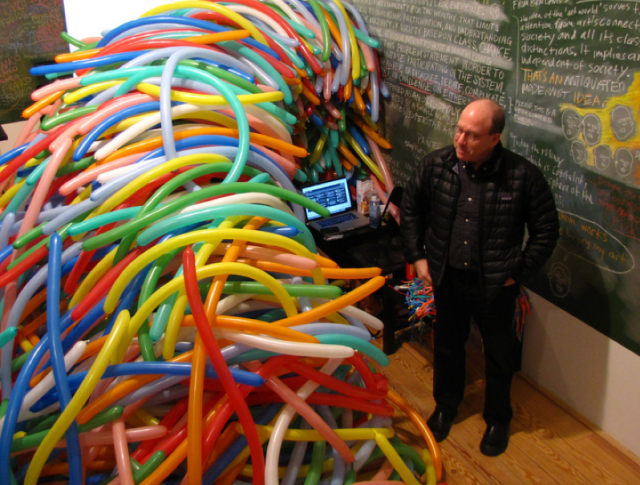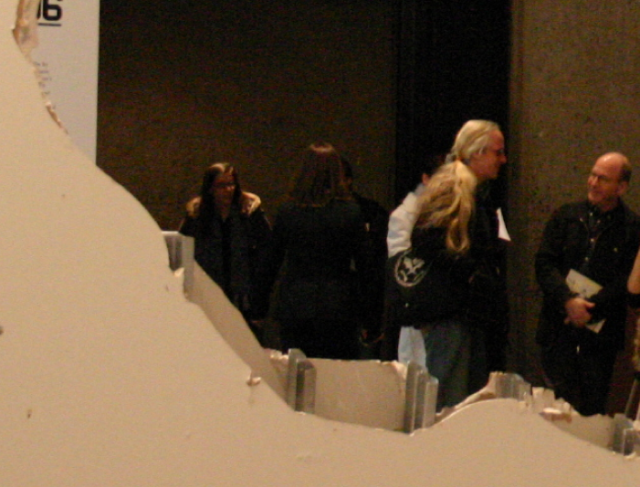Here's Jerry!
Here’s Jerry! After ‘Work of Art,’ Saltz Keeps Chatting: “A Lot of People, of Course, Hate Art Critics”
by Alexandria Symonds

It’s been a week since Bravo’s “Work of Art” ended, and art critic and on-air judge Jerry Saltz’s final recap of the show for New York magazine’s Vulture blog has reached 436 comments. It’s rare, in the ADHD world of blog comments, to keep a conversation about any topic going for a full week. But a Bravo reality competition in its first season, whose average viewership across ten episodes was just 1.12 million viewers? A Bravo reality competition whose winner has already been decided? Were you still thinking about Harold Dieterle a week later? (Who? Exactly.)
In his last recap of the show, Jerry suggested that the comment threads on the site had given rise to a new way of talking about art: in the comments, “an accidental art criticism sprang up, practiced in a new place, in a new way, on a fairly high level,” he wrote.
That idea immediately rankled some in the art world, like critic Christopher Knight, who took serious issue with the idea that viewers could judge art based on a TV show. But it’s hard to argue with the strength of Jerry’s numbers. The interactive barrage started slow, but quickly gained speed: somehow, 39 comments on the first post paved the way for 510 on the eighth. Something was happening here.
To characterize that something, insofar as such a thing is possible: from what I can tell, it involved around a dozen regulars, who commented multiple times on each post, along with many more who dropped in only occasionally. Unlike typical threads on New York blogs, these commenters were not, for the most part, stopping by to make quick jokes or to casually react to posts. They were (and still are, it seems) fiercely opinionated about the show, the contestants, the works, the recaps, and each other. What’s more, some of the show’s contestants leaped into the fray, too-to defend their work, to criticize or compliment the work of others, or, in Nicole Nadeau’s case, to explain that her face appeared splotchy on camera because she was allergic to the show’s makeup.
And then, of course, there’s Jerry. His numerous comments, even if they do not redefine art criticism, must at least redefine prolificacy. Almost any commenter who made a bold assertion or asked a reasonable question was assured a somewhat considered response by one of the best art critics in New York-not a bad deal.
Jerry Saltz is not a man unacquainted with the subtleties of the Internet; he has a famously well-connected Facebook page. But the Vulture comments are different, and he’ll tell you so himself.
“On my Facebook… people have to behave, otherwise there’s an authority, me, that can get rid of them,” Jerry told me in an interview last week. “But on that stupid New York magazine page, you know, I wasn’t even the authority. Anybody could say anything, I don’t have any say. Nobody had to reveal their identity, except me, which made, I think, me more vulnerable and helped level the playing field.”
The playing field was about as level as it gets: it collapsed creators, critics, and viewers of art into one democratic space. In the comments, nothing besides their usernames distinguishes Jerry or the artists from the other commenters. Everyone’s opinions appear in the same font and the same size. Jerry balanced this equal aesthetic weight with an equal critical one by taking every comment seriously, and the results surprised even him.
“I knew the reason I got involved with this is to see if criticism could exist on a different stage,” he said. “But it never occurred to me that the stage that I would be on would be this kind of strange middle territory online. I’m still amazed. I don’t know what to do with it.”
* * *
Jerry’s recaps are unerringly honest, explaining all the divergences between his experience of the show and the finished product that Bravo delivered to cable TV every week. He wrote about editing decisions that may have been unfair; he wrote about the producers stopping filming to ask him to adjust his “hanging brains.” (Incidentally, that was the post that garnered the most comments, so far.) This alone was rather unusual for a reality competition that was still airing: usually, reality-show participants who want to criticize the shows they’re on have to wait until the threat of its hurting ratings has disappeared.
According to Jerry, Bravo didn’t care one way or the other. “I never read the contract, I never had an agent… So, I don’t know what the contract says. They haven’t said anything to me about it,” he said. To at least some extent, this is Bravo’s modus operandi-witness Simon van Kempen’s Twitter account during any airing of Real Housewives of New York, or Tom Colicchio’s discussion of “pea-puree-gate” on his Top Chef blog, or Bravo exec and on-air personality Andy Cohen’s network-sanctioned willingness to have a good time online. The Bravo scheme is to embrace the meta-narratives-it’s good for business!
On Vulture, Jerry is more or less a free agent-a sort of Pied Piper leading neophytes into the daunting world of art criticism. “We might have accidentally mapped out-might have occupied an unmapped area, kind of what I’m calling the ‘wilder shores of criticism,’” Jerry said, an idea he reiterated in his final recap.
“These outer banks where people that don’t normally have any access-to the power, the opinion, the mainframe of the art world-were suddenly involved,” he explained to me. “And it was coherent, as opposed to most blog comments sections, that just kind of like, you know, people write under anonymous names and they tear each other new assholes. And I love doing that, myself, but it’s a big mess.”
Jerry’s a self-effacing sort of guy who probably wouldn’t admit it, but this “multi-headed, non-hierarchical conversation” didn’t arise out of nowhere. His methods of addressing the commenters were crucial to the existence of any kind of coherency in the threads. Though he’s a professor, he insists he’s not the Socratic-method type-”My idea of teaching is I go in one-on-one with students in their studios and I yammer!” he said-but read through all the comments and you’ll have taken a crash course in art criticism, conducted in exactly that way.
While Jerry certainly answered a lot of questions, he also asked a lot of them. If a commenter had a bone to pick with the judges’ choice of elimination, Jerry might ask him who deserved to stay and why. If someone complained that none of the art in an episode was any good, he might ask her to name five works of art she enjoys, and why. Maybe flattered by the attention, or maybe because they had truly begun to engage with the work, commenters kept responding, to Jerry and to each other. The end result for any given episode is not wholly unlike a transcript of an unruly undergraduate seminar.
“I think that a kind of ‘survival of the clearest’ started happening,” Jerry said. “I think that people started instinctively understanding that if you write a giant block of type, even if you’re Albertine Einstein, no one’s going to read it! The time is different, the eye works different, there’s no intimacy between you and the page. It’s not like Artforum. So I think that people started actually making sense.”
* * *

One of the keys to Jerry’s success with the Vulture threads is his thick skin. Many commenters, particularly at the beginning, wrote rather unkind things about him, the show and his involvement on it. “A lot of people, of course, hate art critics. I understand that,” he said. “You want to shoot us… shoot the art critic for being an arrogant blowhard who’s saying this is better than that-how can you possibly know? And a lot of people, early on, got on it to tell me that,” he said. “By not taking it personally and by taking every single thing that was written there seriously, I think that helped set a certain tone.”
He engaged with these people in the same way as he did with everyone else: by respectfully asking them questions, or by offering up a small, sharp dose of self-deprecation. To a commenter named NELSPHIGHBERG, Jerry wrote a short note: “I am sorry you don’t like my writing, my attempt at humor, or the reality TV show that I am on. I often do not like these things as well.” To a regular commenter named Lorax, he wrote: “I like the way that you write so I am sad to hear you say that the reality TV show that I am on is ‘ridiculous,’ ‘insipid,’ ‘spitefully edited,’ ‘sensational,’ and ‘content-false.’ You may be right.”
This, by the way-”you may be right”-is a classic Jerry Saltz move. I, an occasional commenter, at one point suggested that an artist who’d once worked for Jeff Koons had ripped off that artist’s style with one of her sculptures. Online, he disagreed politely and ended his comment with his oft-repeated phrase: “You may be right.” During our interview, when he asked me to remind him what comments I’d made, his response to that one was immediate. “Oh, no, you’re wrong, Alex!” he exclaimed, and laughed.
And he was right-I was wrong! But when he’d allowed weeks earlier that I might be right, it was a genuine rush. I’d made a valid point, maybe, and Jerry Saltz had acknowledged it. I was hooked; I knew I’d be back.
* * *
Much of what Jerry said in the course of our conversation suggested that he believes that each of the commenters, and anyone else for that matter, is just as qualified to talk about art as he is. “I’m ‘untrained,’ too,” he wrote in his first recap. “I have no degrees and never went to writing school. Like most people in the art world, I’m basically making this up as I go.” He has been, however, for quite some time a talented, established, and influential art critic; the commenters know it and he knows it, too. And the art world knows it. He and his wife, Times art critic Roberta Smith, often stomp through Chelsea galleries on the same days but separately, on different paths: she is cool and quiet, often in black, while he is constantly running into someone and having a boisterous conversation in someone’s echoey gallery. Their individual visits are regarded as equally important. This system of a critic’s visit and later review is the opposite of what Jerry has accomplished online. The sense of peership and continuous conversation on the comments pages and Facebook-created by the nature of the platform and executed and driven home by Jerry-was essential to the development of this strange little world.
Jerry himself doesn’t know whether the comments on his posts have actually “revolutionized” art criticism: like a proper critic, he knows the most important measure is the test of time. “If no one practices it after this, it’s not useful,” he said. “It was only useful to me and to the people that participated. That was it!”
At the end of our conversation, he offered a reminder. “You know this from my comments,” he said, which was true. “But you can write anything you want about me, and I don’t take it personally.”
Alexandria Symonds was rooting for Abdi.
Photo (top) by Man Bartlett from Flickr.
Photo (bottom) by Mark Berry from Flickr.
